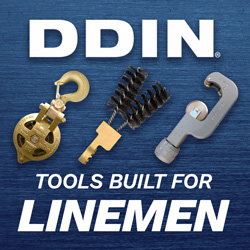Taking care of your grounds and jumpers
A lineman’s ground and jumper cables look and feel like they’re built to last forever, but looks can be deceiving. They get tossed in the truck, dropped in the mud, left hanging in the rain, and generally overlooked. With everyday use, we start to take them for granted. And slowly the wear and tear adds up, compromising their mechanical and electrical reliability. That’s why the care, maintenance, and regular testing of your grounds and jumpers are so important.
Take your personal protective grounding personally
Grounds
Grounds are essential cables that contribute to your personal protective grounding equipment. Before working on a de-energized powerline, a grounding cable is attached to the conductors. If, for some reason, the circuit suddenly re-energizes, the grounding cables will help to redirect the hazardous current to ground.
A re-energized powerline circuit can and does happen for a number of reasons, such as human error, static build-up, stored charges, and more. And with the higher loads and power capability of our electrical grid these days, you don’t want to take any chances. Use only well-built and well-maintained personal protective grounding equipment.
Jumpers
Temporary mechanical jumpers are devices used to carry electric supply circuits continuously for a short period of time. These cables are insulated to protect the lineman from hazardous voltages while performing their work.
What are personal protective grounds and jumpers made of?
A cable set looks pretty straightforward with a couple of clamps and some cable. But they are actually highly engineered to withstand a high current for the maximum amount of time it takes to clear a short circuit. Whether you order a pre-made or a custom cable set, make sure all the components meet industry standards. Here, at Tallman, we make our own grounds and jumpers:
- Grounding Clamps: There are several types of clamps for different situations. Often a mix of aluminum and bronze, each clamp also has a “fault current” rating, which measures a component’s ability to withstand a high current for the length of time needed to clear a short circuit or “fault” before part failure.
- Jumper Clamps: Choose from hand-applied floating heads or stick applied clamps.
- Grounding Cable: Grounding cables are made to withstand maximum potential faults. Each cable set has variable elements, like conductor diameter, strand count, cable size, and a maximum voltage rating. Make sure they meet or exceed ASTM standards. Grounding cables are available in many different color jackets with yellow, black, and clear being the most common.
- Jumper Cable: Jumper cables have an ampacity rating and insulating voltage rating. Voltage ratings are available in 15kV, 25kV, and 35kV.
- Ferrules: A ferrule connects the clamp to the cable. This small component might seem less important, but it is vital to keeping the set together. It can be one of the first components to degrade. Choose from shrouded or unshrouded, threaded or plain.
- Elbows: A grounding elbow visibly grounds cables, transformers, switchgear, or other equipment. Available in 15kV, 25kV, and 35kV.
With so many options and variables to choose from, finding the right cable sets for you might feel overwhelming. How will weather affect your grounds? How committed to quality is the builder of your protective grounding? The surest way to get the answers you need before you purchase protective grounds or jumpers is to talk to an expert.
Keep an eye on your grounds and jumpers
We can’t stress this enough: check your grounds and jumpers immediately before and after use. If anything looks out of order, do not use it. Here are a few things to look for when inspecting your grounding and jumper cables:
A proper inspection of grounds and jumpers involves thoroughly inspecting the cable to ferrule connection, as well as checking for any broken cable strands, stress fractures in the ferrule, incomplete/inadequate crimps, or corrosion on the cable or ferrule. Inspect small clamp parts, such as screws, saddles, jaws, and eye-screws for damage and functionality. Clamps must be complete with all parts as provided by the manufacturer. Assess the integrity of the heat-shrink strain relief during the inspection process. Replacement is required if it is split, loose, peeling, deteriorated, or if it has been determined that it is no longer providing adequate strain relief.
Electrical test your protective grounds
While visual inspection is important to maintaining the reliability of your protective grounds, it’s only one part. Electrical testing by a qualified third-party who can certify your cable sets and components is absolutely essential.
Currently, there are no mandated testing intervals for grounding equipment. However, it’s a generally accepted best practice to submit your ground and jumper sets to an electrical test once a year. Factors such as work conditions, how often the equipment is used, and crew care and maintenance of the equipment can influence testing intervals.
For exceptional testing, repairing, and cleaning, you can trust Tallman. Each ground and jumper are thoroughly inspected by qualified individuals trained specifically for this task. Jumpers are subjected to an insulation test as well as resistance. Each ground and jumper is labeled with company name, test date, along with a unique serial number.
Accessories for your grounding and jumpering equipment
We’ve covered the essentials of grounding and jumper cable sets. Here a few accessories you might consider as well:
- Vinyl ground set bags
- Temporary ground rod
- Rotating ground adapter
- Cluster bracket
- Insulated hanger
- Ground Flags
- Traveling Grounds
- Jack Jumper
If you’re just starting out as an apprentice, you may want to check out the resource What tools do linemen use?
For the best tools for linemen, trust Tallman
As an employee-owned company, we understand what it takes to take care of each other. That’s why Tallman Equipment Company only builds, repairs, and sells the very best lineman tools, gear, and equipment. For years, linemen have turned to Tallman to get them home safely. Check us out today, and see how we can help you stand tall with Tallman.







0 Comments